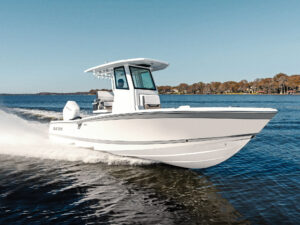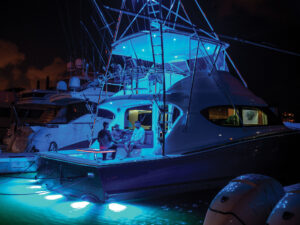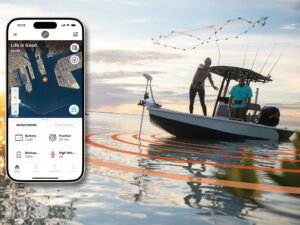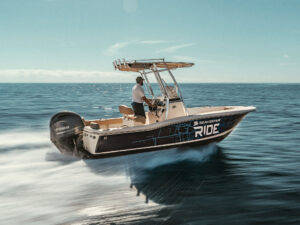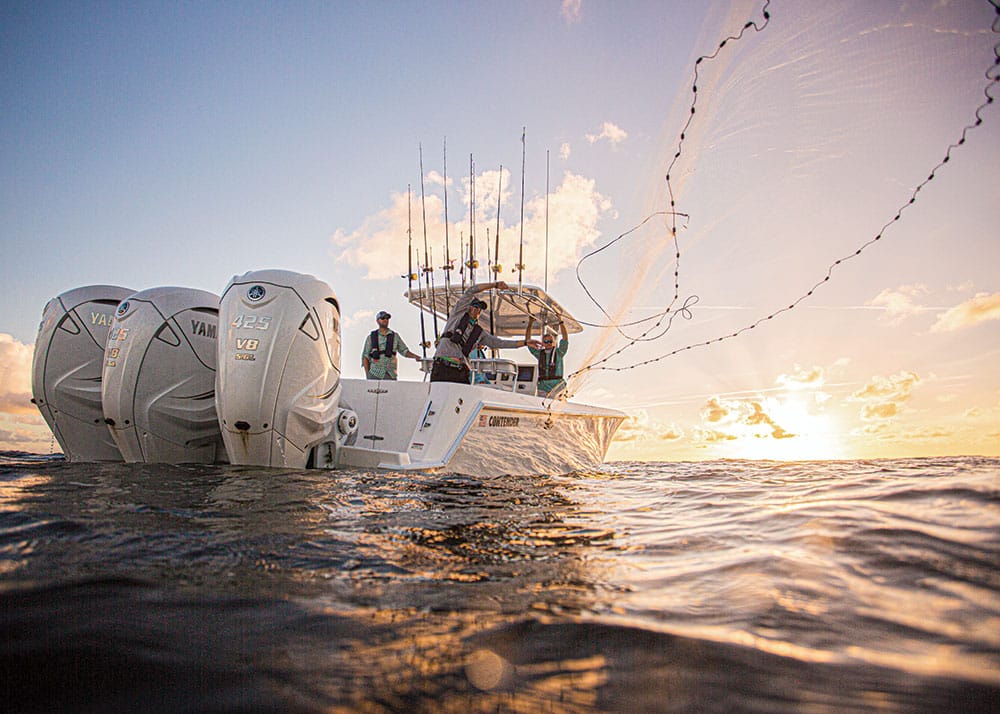
Some have likened offshore waters to a vast blue desert. Indeed, you can troll for miles and miles without seeing anything. But suddenly things change. You happen upon a patch of ocean that springs to life. Flying fish skitter above the waves. Frigate birds swoop down from on high. Schools of ballyhoo shower across the surface. You spot your quarry: the unfurled dorsal fin of a sailfish as it attacks bait. Schools of mahi, charge the boat. Blackfin tuna explode in a feeding frenzy. This is no desert. Hands tremble as you pin a live bait to your hook. You cast. Your bait lands in the epicenter of the action, and in a nanosecond, line whirls off your spinning reel in a blur. You close the bail, the line cinches taut, and the drag screams. This is what you’ve come for. This is offshore fishing at its finest. Getting here, however, is often a journey that begins well before you leave the marina or launch ramp. For many anglers, it begins as a quest for a boat that fits their type of fishing, their taste in design, their boating lifestyle and, of course, their budget. Plus, for blue water, having a boat that offers offshore capabilities, sufficient range and key safety features such as self-bailing decks and navigational electronics is critical. Helping you find the right boat that fits your preferences for offshore fishing is what this section of the 2020 Fishing Boat Buyers Guide is all about. You will find the guidance you need in the pages that follow. So get out there and find the boat that will enable you find the fish amid the vast blue desert.
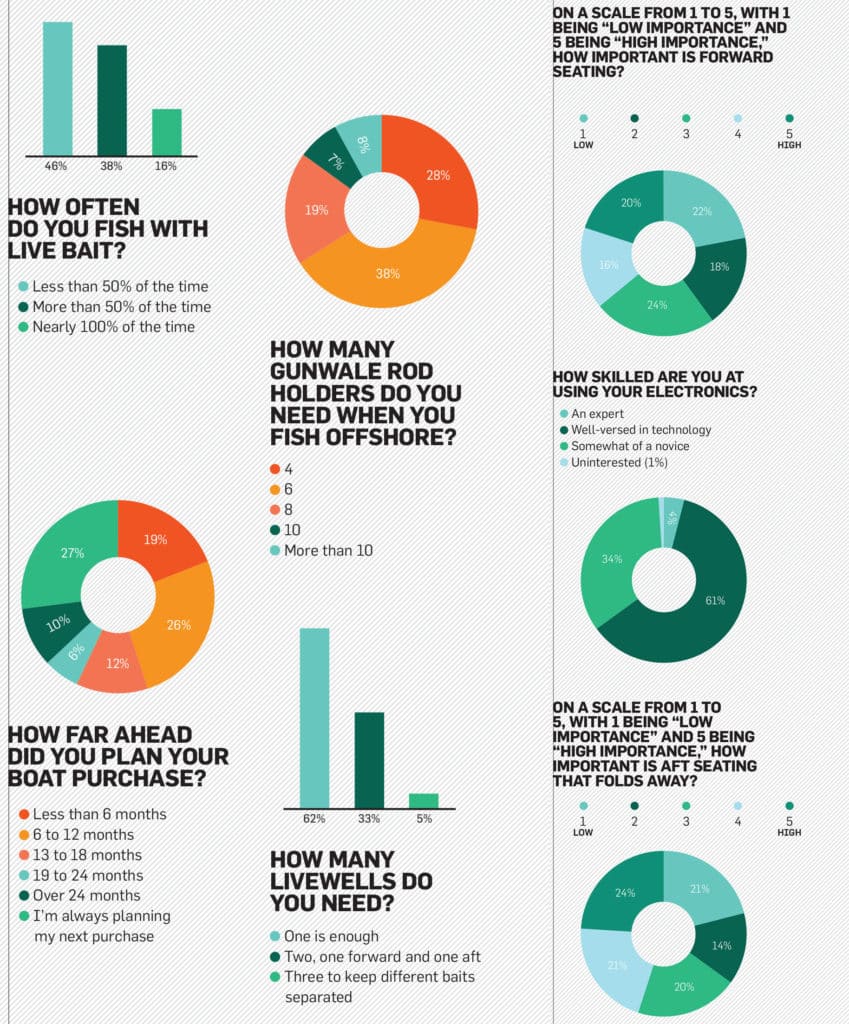
Center-Consoles
By Jim Hendricks
Today’s most popular offshore fishing machine takes the form of an outboard-powered center-console boat. More than 30 percent of respondents in our survey own such a model—more than other kinds of saltwater fishing boats, and three times the number who own traditional inboard sport-fishers. The reason is simple: The center-console offers unfettered 360-degree access to the rail to cast, net bait, fly kites, troll dredge teasers, deep-drop, man the anchor, and battle big, powerful fish. But there’s more. Center-consoles have grown to sizes that imbue them with offshore capabilities that few could have imagined a decade ago. Some new models in this genre are pushing into the 40-, 50- and even 60-foot range.
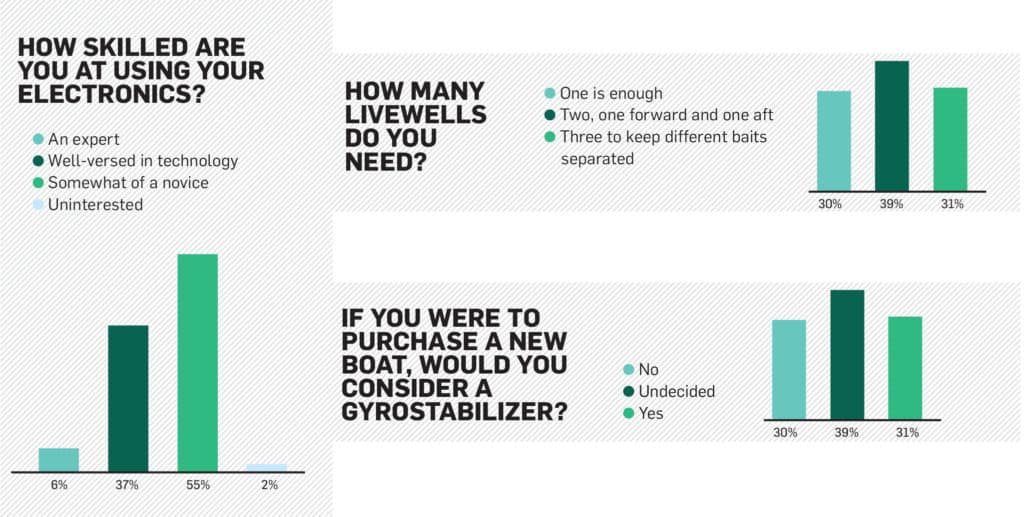
Power and Comfort
The trend toward bigger center-console boats is spurred by the introduction of ever-more-powerful outboards. Motors ranging from 300 hp all the way up to 627 ponies—bolted to transoms and brackets in triple, quadruple and even quintuple configurations—enable the development of big center-consoles, many of which reflect lightweight fibers and vacuum-infused resin construction. Big outboards, combined with advanced computer-aided running-surface designs such as step-hulls and multihulls, smoothly propel offshore center-consoles to speeds that leave -lumbering diesel sport-fishers well astern.
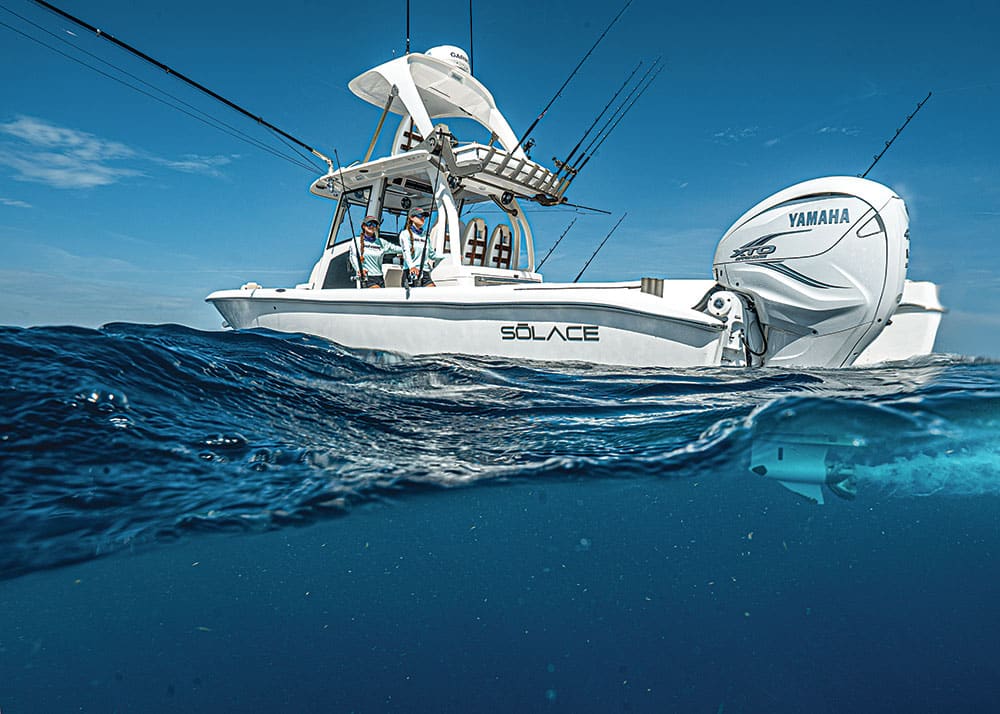
Yet, this trend extends beyond performance and fishing. Offshore center-console boats allow more room for creature comforts such as posh loungers, foldout cockpit benches, supportive helm chairs with flip-up bolsters, mezzanine seating, and roomy, well-appointed console interiors with convertible berths, marine toilets, showers, air conditioning, and even galleys, expanding opportunities for cruising and overnighting. Plus, many consoles now come with three-sided, full-height glass windshields to safeguard the helm from wind blast and spray, a benefit that anglers and nonanglers alike will appreciate.
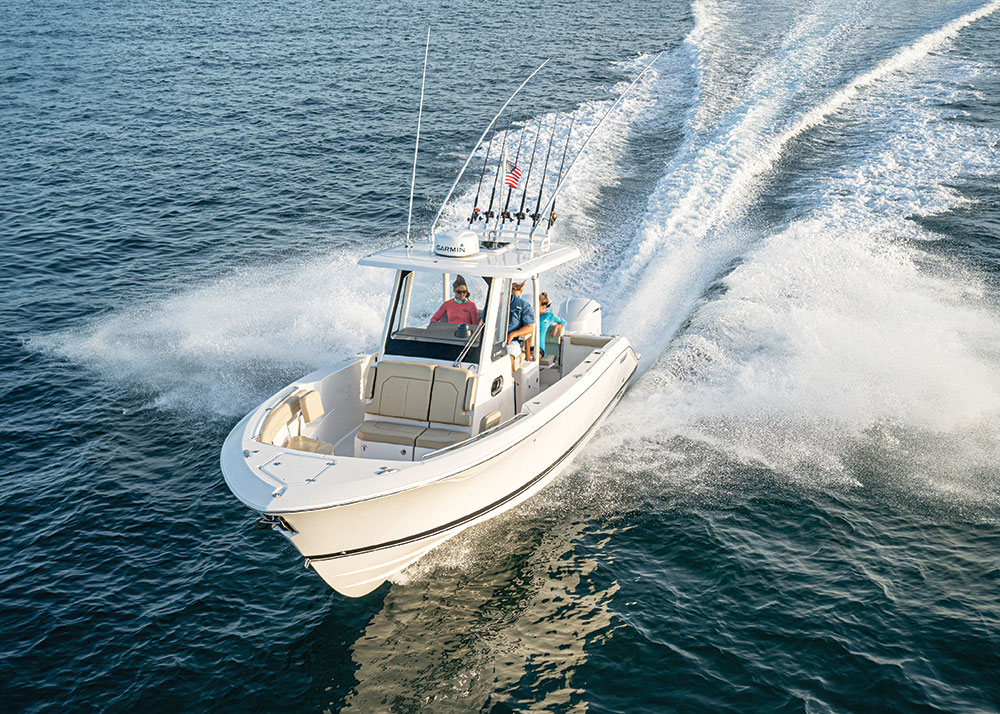
Though there are many elements to consider in the purchase of these boats. Let’s take a closer look at four of the rapidly evolving and practical features contributing to the growing popularity of the category. These include joystick systems to ease docking of bigger boats in tight quarters, and to maintain boat position and drift angle while fishing; networked digital marine electronics that allow access and control of a wide range of onboard systems via multifunction displays; built-in high-capacity livewell systems for effectively transporting live bait to the offshore grounds; and expansion of rod and tackle stowage, allowing anglers to capitalize on a wide range of fishing -opportunities if and when they occur.
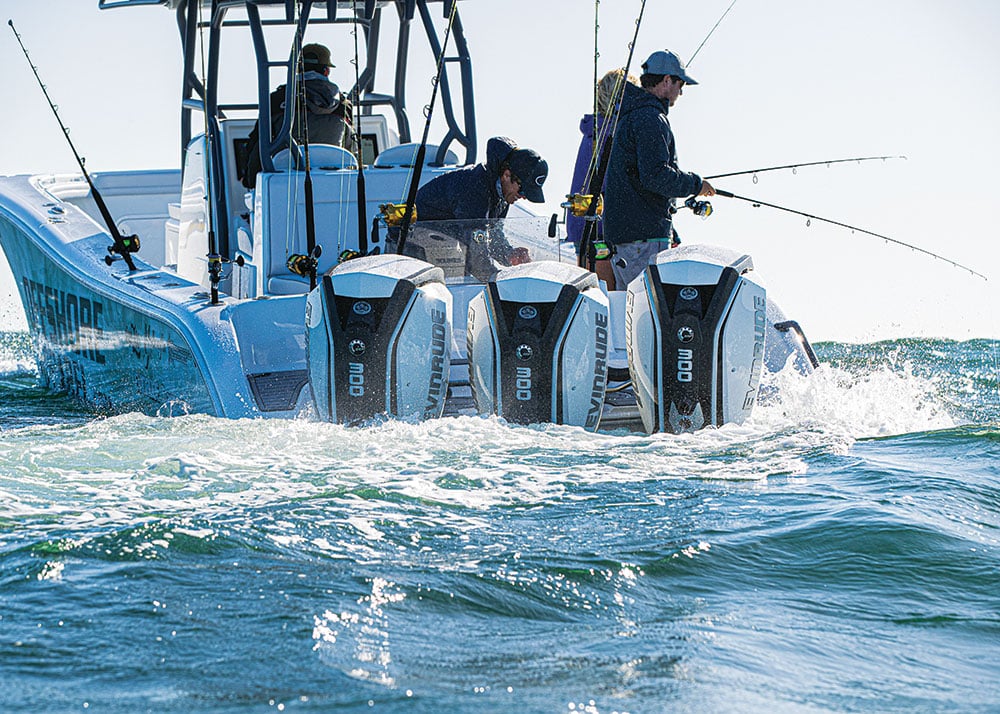
Joystick Systems
Even a moderate-size center-console boat —say, one of about 30 feet in length—can be handful in a crowded marina when trying to depart for a day of fishing or docking at the end of a trip, especially with a strong breeze or powerful current (or both) affecting the boat. As boat size increases, so can the difficulty factor. That’s why you should consider a joystick low-speed -control option, such as Yamaha Helm Master for outboards, when buying a center-console boat for offshore fishing.
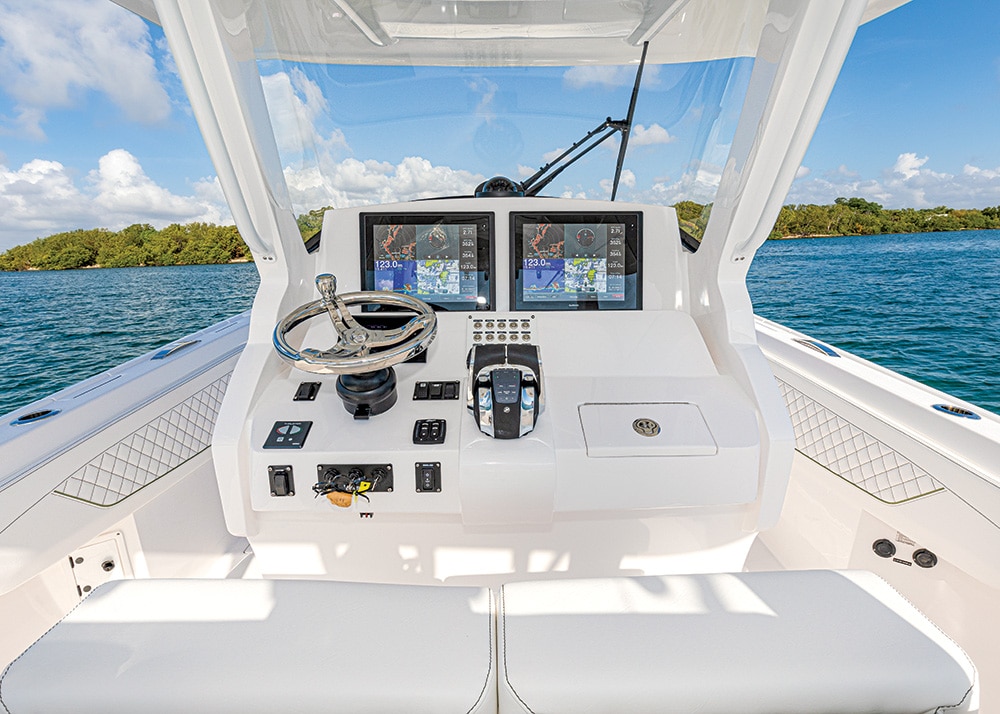
Designed for multiple outboard -configurations, these systems allow you to slowly and precisely maneuver a boat by simply pointing a single joystick control in the direction you want the boat to go—sideways, backward, forward or any angle in between. You can also pivot the boat on its center point in either direction by twisting the joystick control.
Outboard joystick systems work by turning and shifting each outboard independently, and they are generally offered as factory options on new boats. One exception is the SeaStar Solutions -Optimus 360 system, which is available -either factory-installed or as an -aftermarket -addition by a certified installer.
Ease of docking is a great benefit, but there are others reasons to consider a joystick system. Station-keeping functions —also known as a virtual anchor—on the Mercury, SeaStar and Yamaha systems not only let captains automatically maintain position in wind and current, but can also lock in a heading, whether holding the boat in place or drifting over structure.
Yamaha’s Helm Master system includes a Stay Point, Bow Hook, Heading Adjust and Drift Hook. The multifaceted SeaStation system integrated into the SeaStar Optimus 360 joystick steering package features Position Hold, Heading Hold and a combined Position/Heading Hold. Yamaha’s Helm Master system features include Stay Point, which holds the vessel’s heading and position; Fish Point, which aligns the boat with the current and wind to stay put but without maintaining heading; and Drift Point, which maintains the boat’s heading while allowing it to drift over structure.
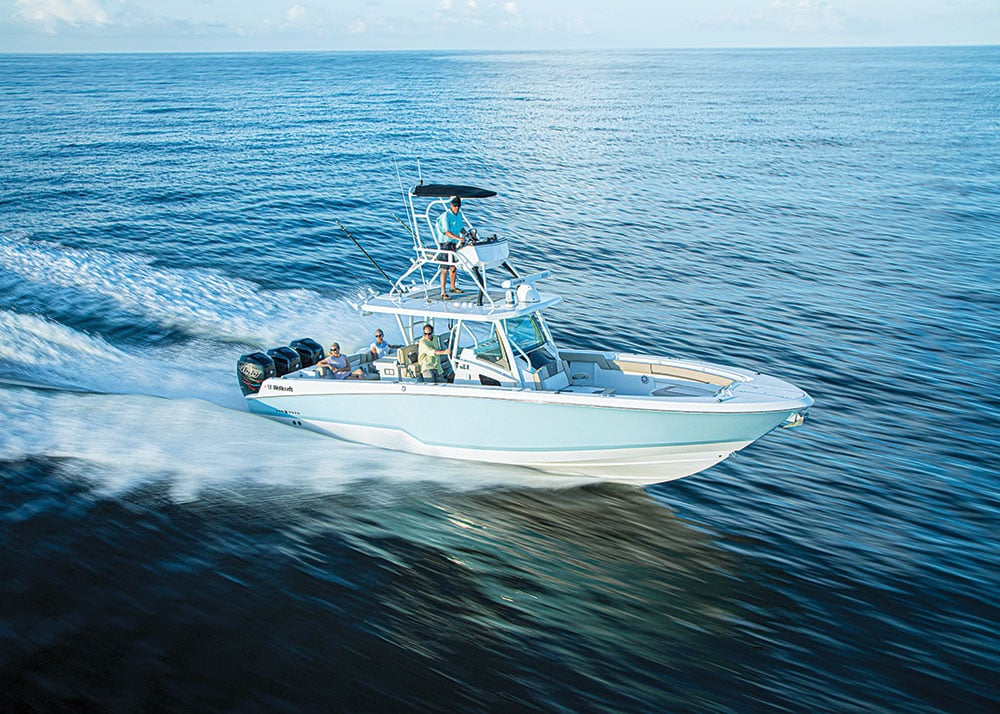
Such systems also available from Mercury, Evinrude and SeaStar Solutions use multichannel GPS positioning data, sophisticated electronic heading sensors, onboard processors, and the joystick independent outboard steering and throttle control. Activating virtual-anchor systems requires only the tap of a button or, sometimes, two. One of the coolest applications would be holding the boat over a wreck on a windy day, allowing anglers to fish straight down.
Editor’s Tip: If you use a virtual anchor to hold the boat in position while you fish, pay close attention to the direction of the current. While the boat won’t move, the current underneath might be running strong and could possibly carry your fishing lines into the outboard propellers, which are constantly working to maintain the boat’s position with engines in virtual-anchor mode.
With features like Drift Hook, Heading Hold and Drift Point, you can keep the boat’s bow pointed in whatever direction you wish while drift-fishing, which can help when kite–fishing. With the Position/Heading Hold, Heading Adjust and Stay Point, you have the benefit of a virtual anchor while also maintaining the bow heading. Systems can be digitally integrated and controlled with third-party multifunction displays. SeaStation, for example, is compatible with current Garmin, Raymarine and Simrad displays. Mercury’s Skyhook interfaces with Simrad displays, and Yamaha’s system networks with Garmin displays.
Digital Integration
The digital revolution is permeating virtually every aspect of our lives, including fishing boats, and especially new offshore center-console models. The trend is centered on touchscreen multifunction displays, or MFDs, which serve to access, view and control a wide range of onboard systems, including electronics, lighting, propulsion, batteries, pumps, entertainment, security systems and more. Over 40 percent of owners of offshore center-console fishing boats have an MFD of 5 to 9 inches, and nearly 30 percent have an MFD that’s 12 inches or larger, per our survey. C-Zone and Naviops rank as two of the leading companies in this revolution, working in coordination with boatbuilders, MFD manufacturers and marine-accessory companies to design customized digital switching networks.
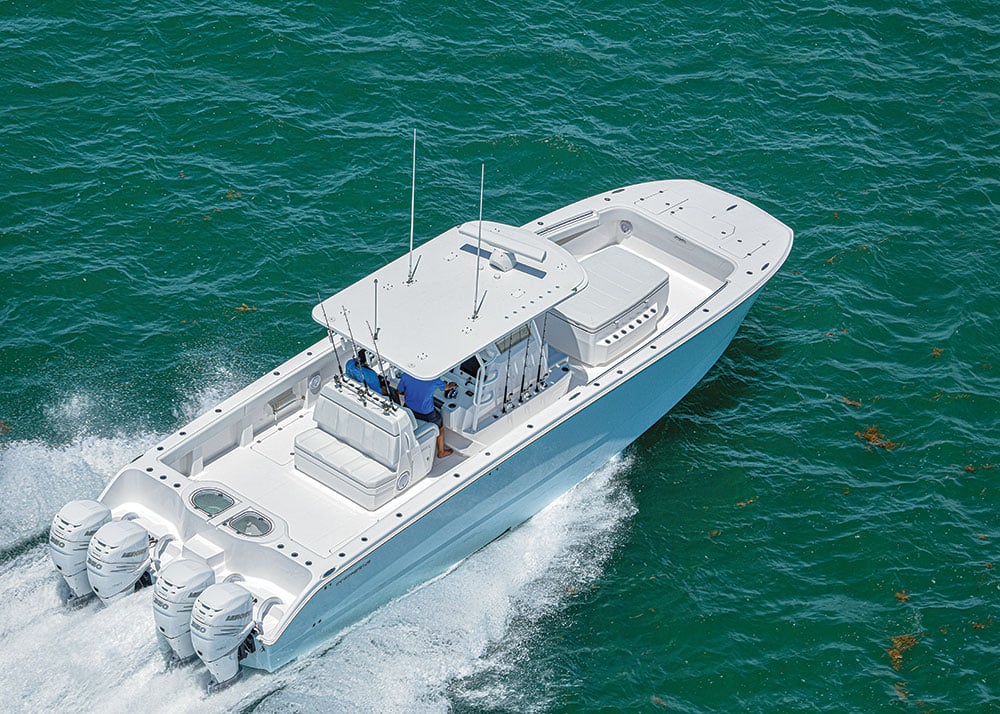
As you sea-trial a new boat, you might not notice any difference versus conventional analog switches. But it’s the versatility of digital integration that makes a difference.
For example, rather than using a switch panel to turn on an accessory, you can access controls on a networked MFD.
Digital integration also means access to a wealth of information about your boat. For instance, many outboards now output vital information via a digital network, and outboard brands such as Evinrude, Honda, Mercury, Suzuki and Yamaha have developed displays to read this data.
With offshore center-console fishing boats now sporting multiple outboards, integrated MFDs reduce clutter and wiring at the helm. One MFD can cover multiple engines.
Available engine data includes rpm, speed, fuel consumption, fuel level, mpg, alternator output, battery voltage, engine temp, trim angle, engine hours and more. Displays will also show maintenance reminders, system warnings and alerts, and engine diagnostics. With all information in one place, MFDs also prove easier to read, allowing captains to quickly recognize relevant engine data at a glance—an improvement over having to scan a sprawling array of dials and gauges. Info can also be shared with other displays.
Livewell Design
Thirty-six percent of survey respondents said that the size of the livewell was a more important aspect to fishability. Bigger is better when it comes to carrying an abundant amount of live bait on an offshore center-console.
Yet baits such as ballyhoo, blue runners, goggle-eyes, mackerel, pilchards, sardines, speedos, pogies and threadfins require more than sheer capacity. They demand carefully designed livewell systems.
One of the most important considerations is the geometry of the livewell -interior. It should be taller than it is wide-—a column shape, so to speak—to minimize sloshing that can slam live baits against the sides of the tank and injure them. This is especially critical for boats that might run in heavy seas. A column of water with a round or oval interior also promotes “milling”—the tendency of the bait to swim in a relaxed circle.
Most new offshore center-consoles have the livewells located in the aft area of the boat, such as the transom bulkhead. This location provides the softest ride to pamper the bait. Transom livewells are also easy to access while fishing in the stern.
Nearly 40 percent of offshore center-consoles have two more livewells, our survey indicates. Some boats have two separate wells in the transom, and some have one in the transom and another -behind the leaning post. A well under the aft deck is also common, and it’s easy to drop a cast net full of bait into it.
The livewell should be free of interior obstructions, such as an exposed standpipe. More-advanced wells have the side drain at the top, plumbed overboard on the outside of the tank. In other wells, the standpipe resides inside a baffle within the wall of the tank.
Pressurizing a livewell is a relatively new method. It keeps bait in better -condition by almost totally -eliminating any air voids. This, in turn, eliminates sloshing. Pressurizing requires a pump system that slightly overfills the well, and a sealed hatch to keep water from spilling onto the deck. Builders often use clear acrylic hatches that let you see the bait without opening the top. A few offshore center–consoles now feature tuna tubes for keeping large baits such as bonito alive until needed. Today’s most advanced offshore center-console fishing boats use pump boxes to purge air that the water pickup ingests while the boat is underway. Otherwise, the livewell water can become excessively aerated, which can kill bait.
Tackle Stowage
Over 50 percent of survey respondents rank rod stowage as the most important aspect of fishability, and 48 percent say it’s tackle centers. Bluewater anglers need more fishing gear in anticipation of finding a wider range of fishing opportunities. For example, the crew might start out the day jigging sabiki rigs to catch live bait with light spinning rods, then switch to conventional outfits for kite-fishing or heavier spinning gear for wreck-fishing. Or a yellowfin tuna might show up, requiring trolling tackle.
What is the best place to stow rods and reels? Many new offshore center-console boats feature vertical rod holders along the sides of the center console. These keep the rods out of the way yet accessible. Front entries to the console interior (as opposed to side doors) and Key West-style tops that narrow forward help maximize the number of rods that can be stowed along the console.

Many offshore center-consoles feature rod holders along the transom, which is great when you’re not fishing. But for unfettered access to the stern whilefishing, you’ll need to move them to other locations. Rod stowage abaft the helm seating, in the area known as a rigging station, is also common. These rod racks—sometimes call rocket launchers—are angled slightly aft and are easy to access.
Many center-consoles also sport rod racks along the aft edge of the T-top or hardtop, but these can more difficult to access because they are up so high.
Gunwale rod holders are generally reserved for outfits that are actively fishing, be it trolling, drift-fishing, kite-fishing, etc. That’s because using gunwale rod holders while underway can expose expensive gear to corrosion-inducing spray.
Most new offshore center-console fishing machines abound with drawers and cabinets for stowing lures, spools of leader line, terminal tackle, needles and rigging tools. These lockers are located in different places on different boats, but one of the most common and convenient spots is in the rigging station abaft the helm seats. This way, you can quickly access tackle and rigging items while prepping lure and baits at the station. Some -boatbuilders locate tackle stowage in cabinets and in drawers on the sides of the leaning-post module, and many center-consoles are equipped with tilt-out lockers in the inwales with trays designed to stow two or three plastic tackle boxes.
What about when you need to leave the boat tied up and don’t want to haul all of your tackle home? Look for lockable rod and tackle stowage.
For rods, these are sometimes built into forward compartments under the bow deck, below the forward lounges or inside the console. General tackle lockers can be equipped with keyed locks to help prevent pilferage.
Editor’s Tip: Your boat has analog gauges, but you want the capability of an engine MFD. If the outboard is a recent Mercury of 40 hp or greater, you can add a compact VesselView Mobile module to the engine and download the free VesselView Mobile app to turn your tablet or smartphone into a de facto engine MFD. VesselView Mobile (for iOS and Android) lets you access and read engine data on your mobile device. VesselView Mobile also displays maintenance reminders, engine alerts and diagnostics.
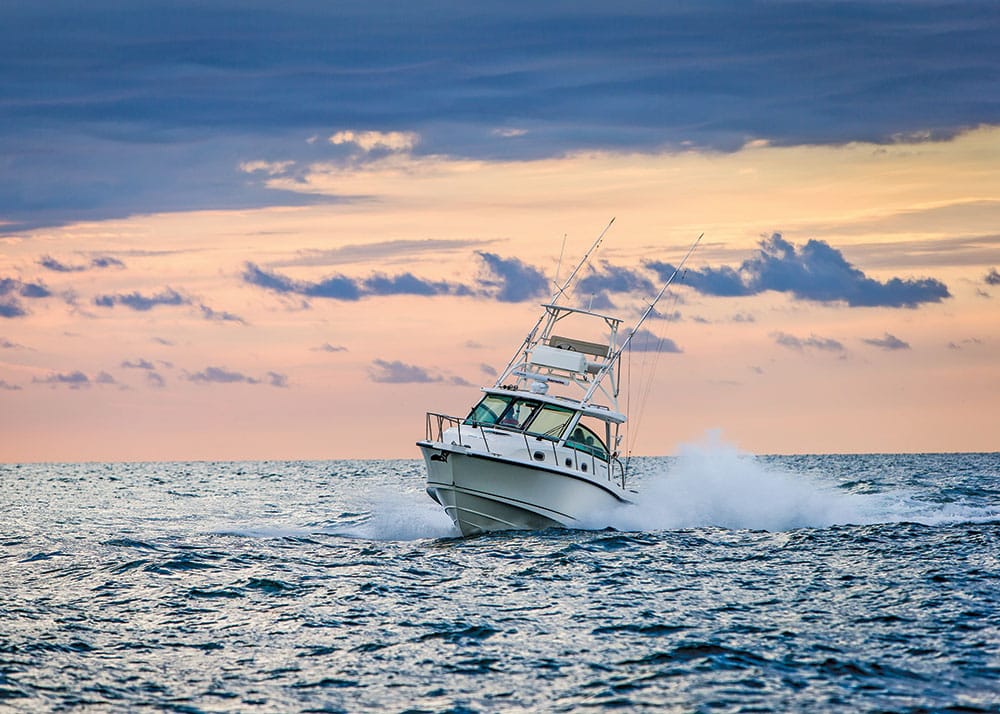
A Step Ahead
By Sam White
Walkaround boats have been popular designs for decades, offering boaters the best of both worlds: a large, unobstructed cockpit aft, with a substantial windshield or curtains forward for protection from the elements, plus accommodations belowdecks for an enclosed head and a V-berth for overnight trips. As the name implies, bow access is via alleys alongside or set inboard of the gunwales, making it much easier to handle the anchor while offshore or bow lines at the dock.
Walkarounds are efficient fishing -platforms that typically feature a large cockpit, with many offering in-deck fish boxes along with multiple livewells, and ample storage for tackle on board (no more toting heavy boxes of tackle on and off the boat each day). Add a set of outriggers and/or downriggers to spread the baits and lures across the water column, and trolling or live-baiting is a breeze from a walkaround. In fact, 84 percent of the Fishing Boat Buyers Guide survey respondents noted that a large cockpit was their No. 1 demand of walkaround boats. At the helm is ample space for one or more multifunction displays as well, while a fiberglass hardtop provides plenty of shade on those hot, sunny days on the water.
In fact, the survey revealed that comfort was another key point. In addition to cockpit shade, 43 percent of respondents noted that having ample aft seating was of high or very high importance to them. Given their multipurpose nature, these boats can just as easily offer cruising options for friends and family as fishing; among the popular options are a small generator for power and to allow for air conditioning belowdecks, a great choice for overnight trips. Also of growing importance is the increasingly affordable Seakeeper gyrostabilizer for crew comfort in seas. An anchor windlass is an option almost always checked on the order form.
Safe and Sound
Although top speed is not among the strong suits, a soft, dry ride is certainly in the wheelhouse for a good walkaround design. In our survey, a majority of respondents wanted fuel efficiency and a comfortable ride in rough sea conditions (69 and 74 percent, respectively). Because the crew is protected from wind and spray, these boats are among the safest and most comfortable on the water.
For power options, the overwhelming majority of walkaround boats are powered by single, twin or triple outboards, offering terrific reliability, fuel economy and -performance.
Our survey respondents were divided nearly in half as to whether a walkaround was best for hardcore fishing (53 percent) or as a comfortable, family-friendly multipurpose vessel (47 percent) capable of fulfilling a variety of roles, including diving, beachcombing and cruising. That speaks volumes to the walkaround design’s ability to easily switch gears from one role to another, doing so safely and in style along the way.
Turnkey Ready?
While the majority of our survey respondents indicated that they preferred purchasing a boat that was already fully equipped with options, many also reported they wanted to add a host of additional items. Among these in popularity were gyrostabilizers, especially for those who said they were spending one to three nights aboard during fishing trips or while cruising with the family. Electronics were another key consideration: A majority of respondents said that they wanted to upgrade from standard sonar to chirp and/or side-scanning sonar units in their walkaround boats. They wanted to add radar and autopilot capability as well.
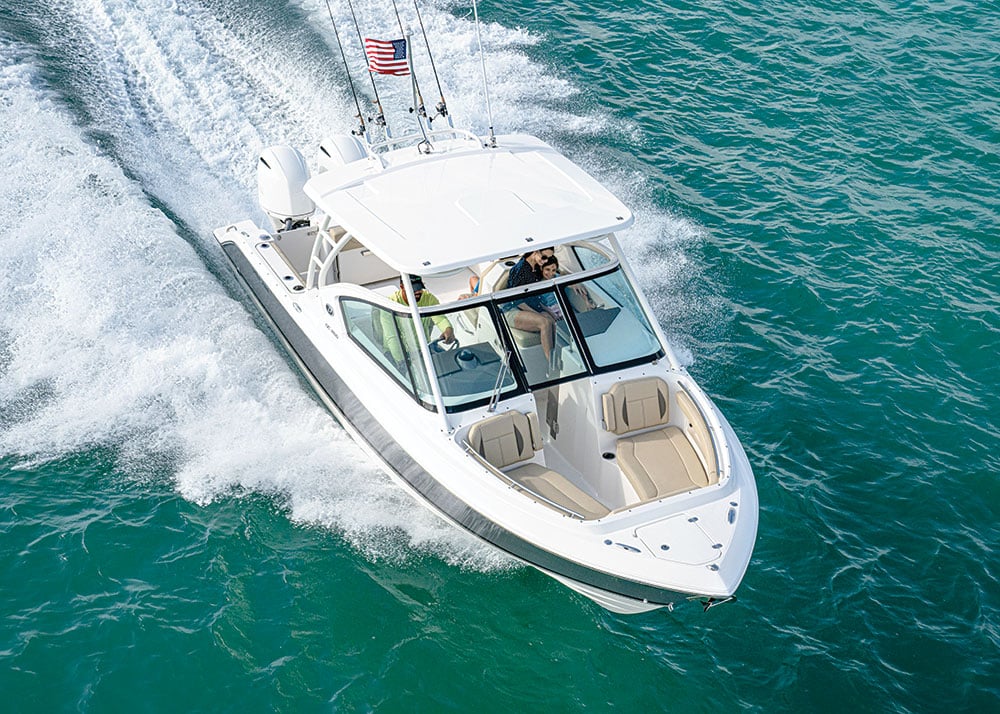
Multi-Purpose
By Sam White
There is truly no such thing as a perfect boat, but there are a few designs that can expertly fill multiple roles, easily switching from hardcore fishing machine to family sandbar cruiser to tow boat for wakeboards and inflatables. One of the most popular of these is the fast-growing category defined as dual-console.
With a walk-through windshield for weather protection and easy access to the bow, plus helm and companion seating and additional seating in the stern, dual-consoles are perfectly suited for hosting families or larger groups of friends. And because there is no need to roam around an outer deck, they are also inherently safe for small children.
Fish and Cruise
While dual-consoles might not have the fishing reputation of a center-console, don’t dismiss them entirely. Because of the forward, offset helm, the cockpit is -remarkably wide open, lending itself to a variety of angling pursuits. Switching gears from trolling to anchoring on a wreck or reef for bottomfishing is quick and easy, in part thanks to safe, easy access to the bow. Few other designs offer this kind of versatility.
And with an emphasis on seating and creature comforts, it’s not surprising that 54 percent of our survey respondents indicated that the reason they purchased a dual–console boat was to spend more time on the water with family and friends. Of those looking to purchase a new dual–console, 65 percent said they wanted a multipurpose fishing boat that could be used for other activities, including cruising and watersports. Features like an enclosed head, fiberglass hardtop, multiple rod holders, built-in coolers and fish boxes, and ample room for electronics displays are present in most dual-consoles.
Safety First
When asked about the primary design and construction of a potential purchase, 72 percent of our survey respondents said they wanted a safe, dry ride in rough sea conditions. This fits the bill perfectly with the dual-console design: In inclement weather, crew can remain seated behind the protection of a large windshield. In fair weather, the forward seating accommodates two to six or more passengers with a first-class view of the passing ocean waters. With many dual-consoles—such as Grady-White’s Freedom series, Boston Whaler’s Vantage series or Blackfin’s DC series incorporating foam-filled construction—these are among the safest boats on the water.
In terms of value, today’s buyers expect a strong brand reputation (72 percent) to good purchase value (75 percent) supported by the reputation. With the ability to fill a wide variety of needs, the -best-built dual-console boats offer an exceptional value by providing a multipurpose platform that seamlessly transitions from an outstanding fishing machine one day to a laid-back family cruiser the next to -business entertainer the day after.
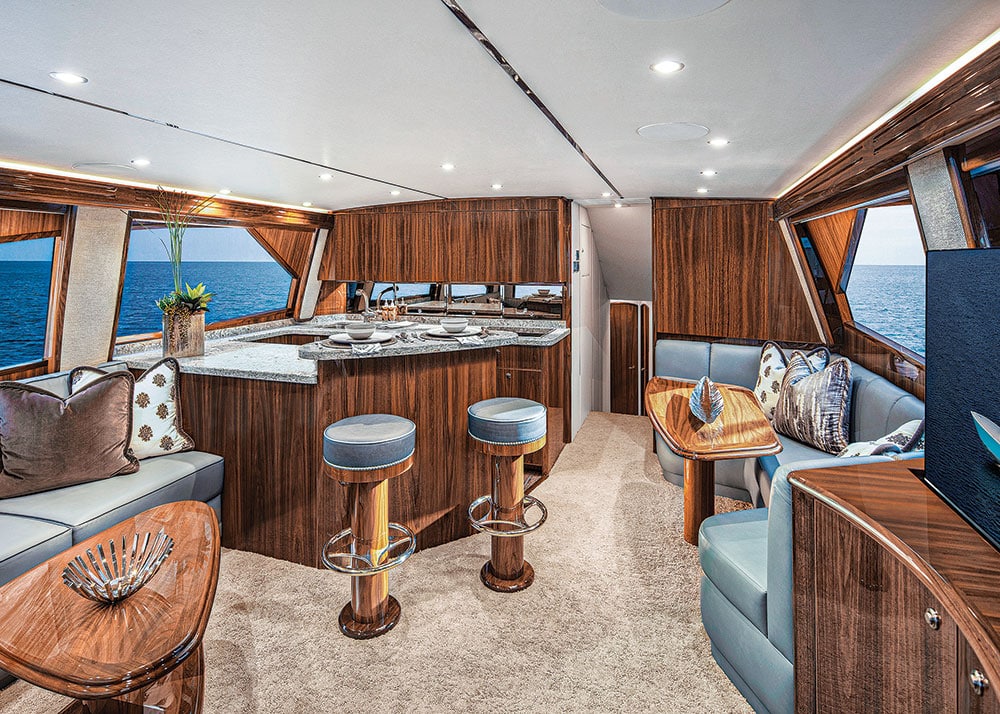
The Big Boys
By Sam White
Inboard-powered sport-fishers are the top of the heap when it comes to offshore fishing. They are usually powered by at least a pair of reliable diesel engines set within the boat’s hull, not outboards exposed on the transom. They can be a convertible design, where the primary steering station is located on the flybridge, or an express or walkaround style, where the primary helm is on the command deck below, with a second station located in a pipework tuna tower 40 feet above.
Long-Range Fishability
A significant benefit of inboard-powered boats is their ability to be self-sustaining for extended periods of time. Even smaller vessels in the 40- to 50-foot range are equipped with generators to supply ample power while away from the dock to run an ice maker, watermaker, air conditioning, a full galley, and a slew of other amenities. So whether you’re targeting tuna and swordfish in the distant canyons of the Northeast, overnighting in the Gulf of Mexico, or running across the Gulf Stream from Florida to the Bahamas, being able to fish in comfort for days at a time is where inboard boats truly excel.
Do Your Homework
When you’re shopping for an inboard-powered boat, myriad factors come into play. In our 2020 Fishing Boat Buyers Guide reader survey, the overwhelming response when purchasing a new or used boat was to thoroughly research your purchase. Look at as many models as possible from different builders in order to get a feel for their amenities and practicality. Consider quality of construction and long-term durability, and the hidden costs of boat ownership. These include annual maintenance and upkeep, in-water dockage, insurance, the cost of a professional crew if needed, and many other factors. We haven’t even added in bait, fuel or tackle to go fishing at this point. But if you want to tangle with giant tuna, marlin and sailfish, it’s hard to beat a comfortable, reliable inboard boat.
Another bit of advice from the reader survey: Always buy larger than what you think you might want. These boats seem enormous sitting at the dock, but in the middle of the vast ocean, they get a lot smaller. When the weather kicks up on the way home, you’ll be happy to have a few extra feet to help span the distance across the seas and smooth out the ride.
Performance
In years past, inboard boats were considered the slowpokes of the sea, with a pair of loud, clattering diesel engines leaving a haze of exhaust in their wake. No longer. Today’s engines are among the cleanest-burning imaginable, leaving nary a trace of exhaust smoke (or smell). Modern inboard boats are capable of cruising from 20 to 35 knots, with top speeds approaching—or exceeding—40 knots or more. However, the top three responses from our reader survey regarding performance for inboard boats noted a focus on a soft, solid and dry ride in rough conditions, as well as good fuel economy at cruising speeds. With an inboard boat, you might not be the first one to the fishing grounds, but more than likely you’ll have a much more comfortable ride getting there and back, while also enjoying amenities such as an air-conditioned salon, hot meals in the galley, and a full head with shower.

